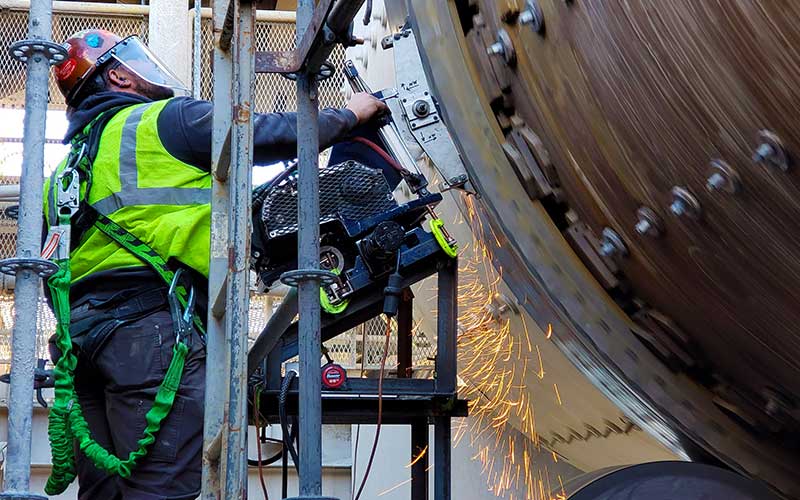The constant rotation and heat stresses associated with rotary dryer applications in the bulk solids processing industries make proper maintenance pivotal to maximizing equipment service life, minimizing maintenance costs, and preventing unnecessary downtime.
With over 70 years of experience as the industry’s leading original equipment manufacturer of custom rotary dryers, FEECO has the tools and expertise to keep your dryer running its best.
Routine Rotary Dryer Maintenance
Measurements to Monitor
Plant managers can often catch problems before they occur through regular inspections and monitoring. One essential aspect of rotary drum maintenance is regularly measuring and documenting key measurements; operators and maintenance personnel should routinely inspect the dryer and take the following measurements to monitor the unit’s mechanical condition:
- Tire Creep (how much more the tire/riding ring migrates around the drum shell during rotation)
- Cold Gap (the amount of space between the inside diameter of the tire and the outside diameter of the filler bars – floating tire assemblies only)
- Float (drum axial loading on thrust roller, discussed below)
- Tire and Trunnion Roller Diameters
- Tire and Trunnion Roller Hardness
Gear Maintenance
Units employing a gear and pinion drive assembly must ensure that gears are properly lubricated at all times. The girth and pinion gears should also be interfacing properly, with adequate root gap. This minimizes wear on drive components, which are costly to replace. Further, gear damage cannot typically be repaired, leaving replacement as the only option.
Replacing Worn Dryer Components
Replace worn components as needed as part of preventative rotary drum maintenance efforts. FEECO recommends a preventive approach to replacement to avoid extended shutdowns due to unexpected failures, as well as to prevent further damage from added stress on all components.
Burner Maintenance or Replacement
While FEECO only utilizes high-quality burners that have proven to be reliable, issues can still occur. Parts such as the nozzle, cone, and sensors may need to be replaced for the dryer to continue to operate as designed.
In the case of old equipment, it may be beneficial to upgrade the burner. Technology is constantly progressing and an updated unit may result in greater energy efficiency and material output, making for a cost-effective upgrade.
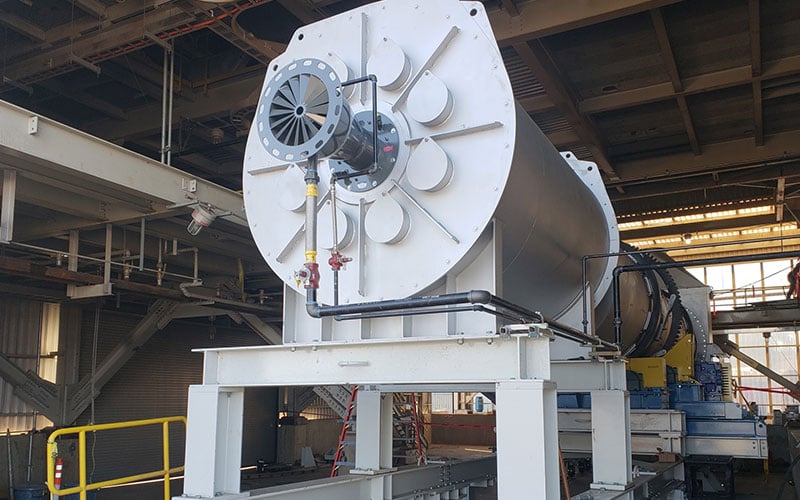
Burner (mounted on a combustion chamber)
Breeching Seal Repair & Replacement
Rotary dryer seals play an essential role in process efficiency by preventing air ingress. This ensures the internal processing temperature is maintained for optimal drying efficiency.
Seals also prevent material from escaping the unit. FEECO dryers are specifically designed to funnel exhaust air, along with dust, to a controlled area. The design is configured to discharge the maximum amount of process material, while still maintaining the desired internal temperature.
Worn out seals can alter this precise system, resulting in poor dust control and inconsistent temperatures, ultimately leading to added plant clean-up and process inconsistencies.
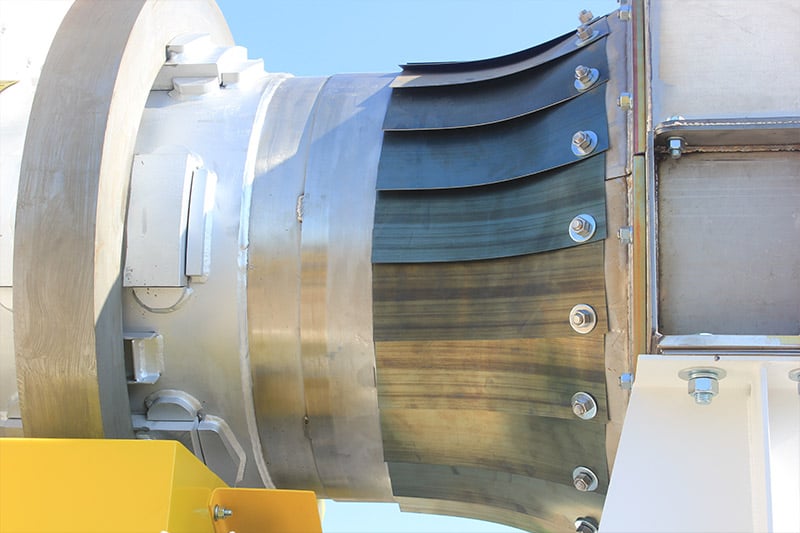
Leaf seal
Common Maintenance Issues
The most common wear and tear rotary dryers experience typically includes:
Rotary Dryer Misalignment
Misalignment is one of the most common issues seen with any type of rotary equipment, dryers included. Alignment issues are common, but should not be taken lightly, as they affect all components of the rotary drum; when a dryer falls out of alignment with its original horizontal and vertical axes, structural and mechanical components experience excessive stress and subsequent wear or damage, making proper alignment a top priority. The drum should always be positioned properly on trunnion bases without deviation from its centerline axis of rotation.
Misalignment can occur for a variety of reasons, but should be corrected with a realignment as quickly as possible to prevent further damage. While a few different types of alignment techniques are available on the market for rotary drums of all types, FEECO recommends the laser alignment approach.
The use of a laser tracking system allows for a faster, more precise alignment than with the use of traditional methods that rely on manual measurements.
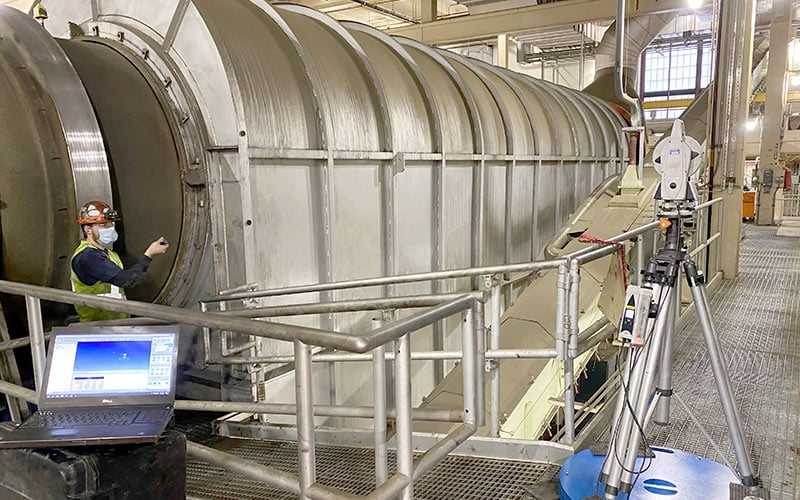
A FEECO Customer Service Engineer Conducts a Laser Alignment
Worn Tires & Trunnions
Wear on tires (riding rings) or trunnion wheels (also known as support or carrying rollers) puts undue stress on various mechanical components and should be addressed as quickly as possible to avoid unnecessary damage.
In most cases when riding rings and rollers become worn, they can be resurfaced through grinding, in which trained technicians use specialized equipment to grind away surface wear, revealing the undamaged surface beneath. In cases of excessive wear, replacement may be the only option, as the dryer slope is otherwise affected.
It’s important to note that worn tires or trunnions typically indicate an underlying issue, most often an alignment problem. As such, the drum should be investigated to identify and resolve the root cause of wear; if the underlying issue is not addressed, wear on tires and trunnions will quickly resume after grinding.
Axial runout, or the misalignment between the drum and its riding rings/tires, can also occur with tires if tire creep is not kept within a certain range. Axial runout is often indicated by vibration or wobbling of the tire.
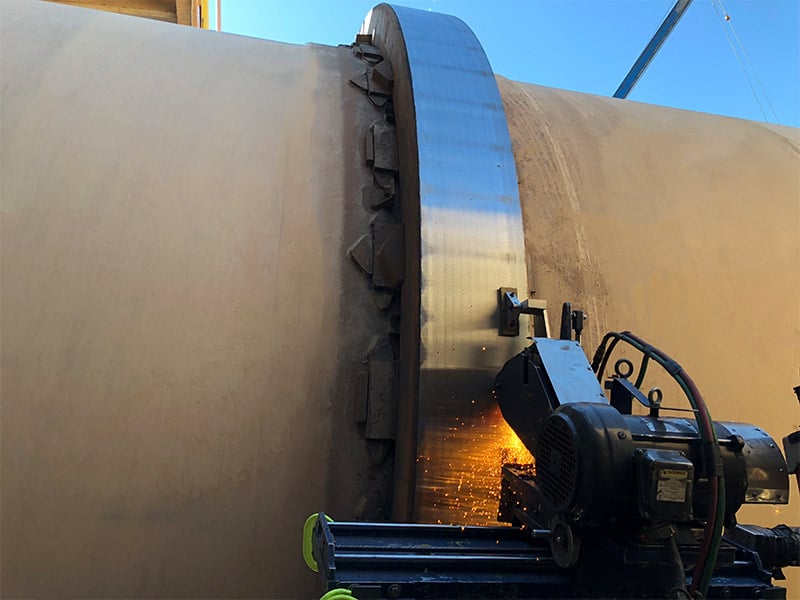
Tire Grinding in progress
Improper Float
Float refers to the positioning of the drum between thrust rollers; ideally, the drum should “float” between the uphill and downhill thrust rollers, not riding hard against either one.
Thrust rollers prevent the drum from drifting on a longitudinal axis. If the drum begins to drift longitudinally (typically downhill), the thrust roller provides a rotating point against which the tire can ride.
While intermittent contact between the tire and thrust roller is permissible, anything beyond that will begin to damage both components and should be corrected as quickly as possible. In addition to damaging these key components, the drum will also experience thrust overload, putting additional pressure on bearings and roller shafts. Excessive thrust can also be a result of over-skewing the bearings in an attempt to train the drum (for this reason it is important to avoid excessive skewing).
The process of correcting drum float is referred to as “training” the drum back into position. This is done by performing a laser alignment and skewing trunnion bearings in very small increments to influence the direction of the drum and the amount of longitudinal thrust it experiences. Training to achieve proper float should only be conducted by a trained professional, as the potential for extensive damage is high if not carried out properly.
Dryer Shell Issues
A rotary dryer shell designed for its intended level of duty should experience little-to-no issue. However, a dryer’s shell can begin to experience issues if the unit is not properly maintained or was operated improperly. This might include thin spots, ovality problems (when the shell is no longer perfectly round), distortion or deforming of the shell, cracks at weld points, as well as other problems. One common cause of shell issues is when operators do not keep the dryer rotating with a hot load, such as in the event of a failure or power outage. Prolonged localized heating can damage the shell.
Top Maintenance Tips
In addition to the basic maintenance procedures associated with all rotary drum equipment (lubricating the gear box, changing the oil, etc.), FEECO recommends the following to maximize dryer service life and avoid unpredictable operation:
Prioritize A Preventative Maintenance Program
The most cost-effective approach to rotary dryers is a preventative maintenance plan. A preventative maintenance program centers largely around routine assessments of the unit, as well as proactively replacing worn parts.
As such, it’s important to build a solid foundation of schedules and procedures to conduct at daily, weekly, and monthly intervals. Catching problems early allows the issue to be circumvented before it can evolve into something more serious or cause process upsets.
In addition to on-site personnel performing regular inspections, FEECO recommends all dryers undergo an annual inspection as well. Annual evaluations conducted by the OEM or other qualified service provider offer much deeper insight into the dryer’s mechanical condition. In addition to identifying areas in need of attention, an annual inspection provides valuable benchmarking data.
Depending on the material being dried, as well as process conditions, these evaluations may need to be conducted more frequently.
Be sure operators and maintenance personnel are trained in both the proper operation and care of the unit. On-site personnel should also thoroughly document all inspections and any changes made (routine maintenance, roller adjustments, key measurements, etc.).
Select the Right Rotary Dryer Service Provider
Not all rotary dryer service providers are the same. In selecting a qualified service provider, be sure to thoroughly vet all options. Moreover, services offered can vary based on the provider, so be sure to select a provider that can meet all of your maintenance requirements.
Take care in selecting a provider that prioritizes safety, efficiency, and getting the job done right the first time. Further, select a provider that will not just treat the symptoms, but will work to identify and resolve the root cause of the issue(s).
Ensure Proper Lubrication of All Components
Ensuring all components are properly lubricated is a vital step in preventing potential damage. Follow OEM recommendations for all components in terms of type of lubricant, amount, and frequency required. Note that not only is too little dryer lubrication a problem, but too much can also be problematic, presenting a fire hazard, damaging grout, and more.
Keep a Parts Inventory
Keeping an adequate supply of wear-critical and operational spares is pivotal to minimizing downtime; having the right replacement parts on hand in the event of an issue can mean the difference between days and weeks of lost production.
Rotary Dryer Audits
Establishing an effective maintenance program can be overwhelming, particularly when the condition of the operating unit is unclear.
In this effort, FEECO offers audits to assist plant managers and maintenance personnel in establishing a baseline of benchmark data, identifying potential problems, troubleshooting issues, and laying out a preventive maintenance schedule, as well as addressing any identified problems.
Contact us today to find out how we can keep your dryer running its best and maximize equipment life for years of reliable processing.

